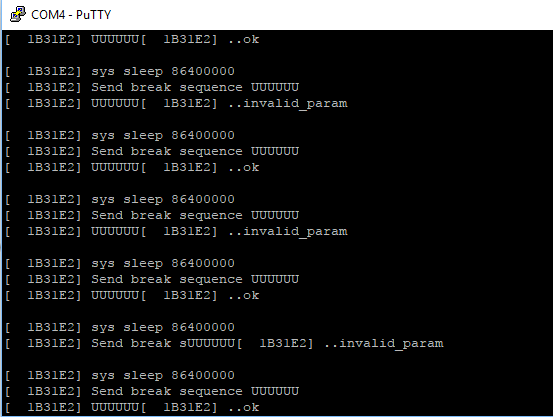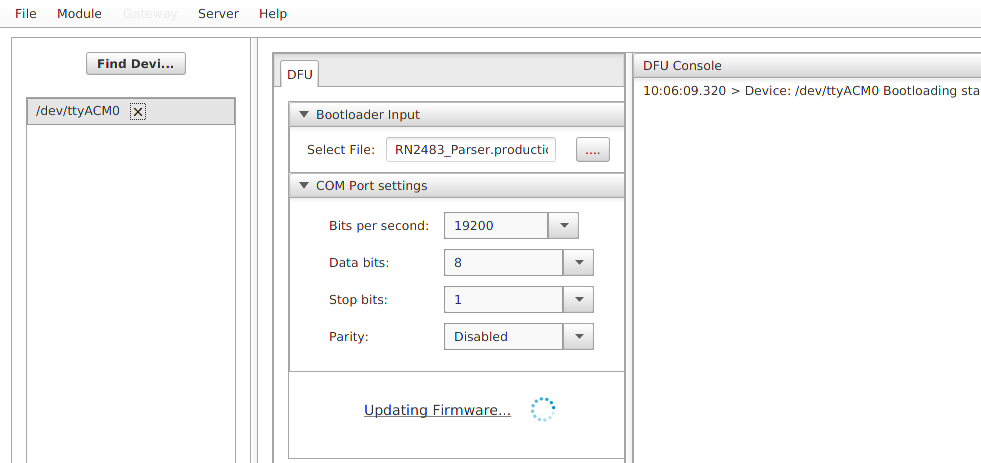Check post 7 (or 8) in this topic for a picture of the adapter I created and use just for that purpose.
For those looking for version 1.0.3 of the RN2483 firmware, the hex file is embedded in the SODAQ firmware updater. Just take the part between the curly braces ( { and } ), remove the double quotes and comma at the end of the line and save with .hex extension.
Resulting file should contain:
:10030000D7EF01F0FFFFFFFF5A82FACF2AF0FBCFB1
… skipping a lot of lines …
:00000001FF
The result can be used to update using the serial port. (Software for updating can be found in the LoRa Development Suite, available on the Microchip website)
I am happy to report successful RN2483 firmware upgrade on Ubuntu Linux 
After a lot of trial and error, I flashed a few devices using LoRaDevUtility.jar from
http://www.microchip.com/Developmenttools/ProductDetails.aspx?PartNO=dv164140-1.
Notes:
- java -version: openjdk version “1.8.0_131”
- run in a terminal: java -jar LoRaDevUtility.jar
- if you see the exception(s) “…Folder parameter must be a valid folder…”:
add the path to some valid folder on your system to the files
~/.java/.userPrefs/dfu/prefs.xml
~/.java/.userPrefs/fed/prefs.xml
~/.java/.userPrefs/toplevel/prefs.xml.
In my case, all 3 prefs.xml are the same actually. Example prefs.xml:
<?xml version="1.0" encoding="UTF-8" standalone="no"?>
<!DOCTYPE map SYSTEM "http://java.sun.com/dtd/preferences.dtd">
<map MAP_XML_VERSION="1.0">
<entry key="FilePath" value="/home/blabla/"/>
</map>
This did the trick for me. Hope it helps somebody out there!
FYI, the firmware is now officially available on the Microchip website:
www.microchip.com/RN2483 (868MHz)
www.microchip.com/RN2903 (915MHz)
… and the RN2903 command ref guide (also on the link above) gives the details of the bootloader process so you can build it in to any device
Hi,
I tried using the same setup as you replacing the path with my username but it still having the same folder error. Is there anything that I could miss out?
Thanks.
Hi,
I upgraded to firmware V1.0.3 and tested with sys sleep command. It doesn’t work as I expected, so I dont know if they fixed this issue with new firmware.
When I sent sys sleep 86400000 to rn2483. It replied “invalid_param”, and then “ok”, and later “invalid_param”. It kept going like that. Can someone confirm this one or did I miss something ?

Thank you
The invalid_param response is caused by the ‘UUUU’ characters you used to wake the device in the previous attempt. Only one 1 needed, additional ones will be in the command buffer resulting in the command looking like
‘UUUUUsys sleep 86400000’ which the module does not recognize to be a valid command.
You can resolve this on two ways:
- just send one U
- if you want to send multiple (not a bad idea), send an additional line termination ‘\r\n’ as well to clear the command buffer (this will get you an invalid_param response, just read it and ignore it)
BTW. There is no need to post screen shots of putty output, you can just cut-and-paste the contents of the terminal window into your message. This allows the forum to index the contents of the screen shot as well.
(Make the text a block quote [the " symbol] for readibilty)
Thank you for this hint! I wasted so much time with this…
I only put the following lines in /home/mattthias/.java/.userPrefs/dfu/prefs.xml and it worked 
<?xml version="1.0" encoding="UTF-8" standalone="no"?>
<!DOCTYPE map SYSTEM "http://java.sun.com/dtd/preferences.dtd">
<map MAP_XML_VERSION="1.0">
<entry key="FilePath" value="/home/mattthias/"/>
</map>Has somebody found out what to to so that the Java app opens the File Dialog Box?
Since I’m working with a Mac I would like to know if there is a simple program for the Mac which allows me to upload the hex file?
Hi,
I’m trying to update the firmware of the TTN Node for consumption problem (The Things Node Battery consumption)-
I’m not an experienced user, looking at this interesting thread I try the following steps:
-
Connect the TTN node to a workstation (ubuntu 64 bit 17.10) USB port
-
Launch the LoRaDevUtility by $ java -jar ./LoRaDevUtility.jar
-
The LoRaDevUtility GUI show a “Finding Devices” for about a minute without result
-
in the meantime the shell shows:
Trying to Connect: /dev/ttyACM0
Connection Successful
Disconnection Successful
Tool List Refereshed
No Server in List -
Next, when I try “Module-Boot Load Recover” from the menu I get
 and after a while it come back to the home GUI.
and after a while it come back to the home GUI.
In the meantime the shell shows:
Trying to Connect: /dev/ttyACM0
Connection Successful
Tool List Refereshed
No Server in List
In Baud Rate Handler
In Data Bits Handler
In Stop Bits Handler
In Parity Handler
/dev/ttyACM0 Bootloader: v1.02
In Baud Rate Handler
FF
08
1D
3C
FF
BF
85
FF
00
00
0F
E0
0F
40
READ_VER
55000000000000000000READ_VER_DONE
READ_VER
55000000000000000000READ_VER_DONE
READ_VER
55000000000000000000READ_VER_DONE
READ_VER
55000000000000000000READ_VER_DONE
READ_VER
55000000000000000000READ_VER_DONE
Trying to Disconnect: /dev/ttyACM0
Disconnection Successful
No FED Selected by the user
In Bootloader Failure
So I imagine the tool is able to connect to the device, but there is some problem to set/get information from it.
Do you have any suggestion about this issue ?
Thanks
try slower speed and how did you connect it ?
I tried both 19200 and 9600 without success …
I connected it from a workstation USB port directly to the miniUSB port on the node
ok… I worked before with that tool but with an rn2483 connected through an usb 2 serial module
that worked … sometimes, on 9600.
I can imagine that the uart connection between the processor and the rn2483 should be broken to prevent problems during upload
Thanks BoRRoz,
May be is a protection as you imagine, but how could I update firmware to avoid battery drain ?
Is the only way the one with a programming adapter as show in post 8 ?
- hope to find out myself because I will receive same node end of the week
I also hope that in some way it will possible to find something to update the node firmware.
It’s a pitty that a Lora demo device wasn’t able to demonstrate one of the most important features of the technology(in my opinion), the low consumption.
This is my experience till now:
When I bought the Node I have to discover myself that there was some high consumption problem, then I’ve received a suggestion (from Microchip ?) to verify the firmware version (but how ?) because the issue should be solved with the last firmware version.
And now I have to find how to update it with a software tool that sometimes work and often don’t (https://www.youtube.com/watch?v=3yorVpfTO2k&t=123s)
Not really an easy way to get started with a demo device that I imagined was ready to demonstrate the strong point of LoRa …
There are several factors for the powerconsumption in this device.
- the choice of the processor, in this case 32U4
- the buildin radio module, here the RN2483
- the software the user uploads
- possibly the firmware version of the radio module
The firmware java tool is from Semtech and not from TTN, as far as I know there is no dedicated TTN update tool.
I agree that in a perfect world a LoRaWAN node can work up to 10 years on a little battery, in reality that’s not true (understatement)
I hope to come back to this subject when I had the chance to do some more research on TTN’s node.
These nodes are studymaterial, how do you connect a node to the network, how do you program a node ect
* the firmware version could/should be an output from ttn.showStatus();